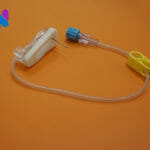Safe nurse-patient staffing ratios are incredibly important in medical care facilities. The proper number of nurse staff can support better care for patients, enhance patient satisfaction, and reduce nurse fatigue.
By law, Medicare-certified facilities must “have adequate numbers of licensed registered nurses, licensed practical (vocational) nurses, and other personnel to provide nursing care to all patients as needed”.
Inadequate staffing levels can lead to increased risks of adverse events, medical errors, and patient dissatisfaction – a scenario that no healthcare leader wants to face.
In this comprehensive guide, we’ll explore the intricacies of nurse-to-patient ratios, regulatory requirements, strategies for maintaining safe levels, and the impact on patient safety and quality of care.
Getting a Better Understanding of Nurse-to-Patient Ratios
IN THIS ARTICLE

A nurse-to-patient ratio is essentially a metric that determines the number of patients assigned to each nurse during a given shift.
Recommended ratios vary across different healthcare settings, such as acute care hospitals, long-term care facilities, and emergency departments.
Factors like patient acuity levels, unit workload, and nurse experience and education play a significant role in determining appropriate staffing levels.
Regulatory Requirements and Mandates for Nurse Ratios
Regulatory bodies such as the Joint Commission, Centers for Medicare & Medicaid Services (CMS), and state nursing boards establish minimum nurse-to-patient ratio requirements for healthcare facilities.
However, these mandates can vary significantly across different states and regions, sparking debates around the merits of mandated staffing ratios versus flexible staffing models based on patient needs.
Patient Safety and Quality of Care
Inadequate staffing levels can have serious consequences, including an increased risk of adverse events, medication errors, patient falls, and overall patient dissatisfaction.
Nurse fatigue and burnout, often exacerbated by excessive workloads, can further compromise patient care quality and safety.
Continuous monitoring and adjustment of staffing levels are essential to ensure that healthcare facilities can adapt to changing patient demands and maintain a high standard of care.
Let’s dive into this a little deeper.
Improvement in patient satisfaction and scores for HCAHPS (Hospital Consumer Assessment of Healthcare Providers and Systems)

Prevention of fatigue, job dissatisfaction, and burnout for nurses
Nurse Burnout and Job Dissatisfaction: Heavy workloads and high patient-to-nurse ratios contribute to nurse burnout and job dissatisfaction. These issues can lead to emotional exhaustion and depersonalization, which impacts the level of care provided.
Turnover and Attrition: A direct link exists between nurse staffing ratios and turnover. Higher ratios place additional stress on nurses, increasing the likelihood of nurse turnover and compounding the nurse staffing crisis.
Retention: Improved nurse-to-patient ratios help in nurse retention by creating a less stressful work environment, thereby addressing issues of burnout and attrition.
Reduction of cost of patient care by avoiding unplanned readmissions
When there are a sufficient number of nurses, they can conduct follow-up calls with patients.
This gives patients access to educational services and allows them to make and stay on top of follow-up appointments. These calls are also an opportunity for the nurses to stay informed of the patient’s current status, so that they can make the proper recommendations.
Patient-Centric Metrics
Patient Mortality: Research indicates that higher nurse-to-patient ratios correlate with lower patient mortality rates. For each additional patient in a nurse’s workload, the risk of patient death after surgery increases significantly.
Healthcare-Associated Infections: Adequate staffing contributes to the prevention of healthcare-associated infections. Fewer patients per nurse allow for more thorough care practices and infection control measures, leading to a reduced incidence of infections.
Patient Readmissions and Length of Stay: Lower nurse-to-patient ratios are associated with decreased readmissions and shorter hospital stays. This improvement can result from more focused patient care and prompt interventions.
Patient Falls: Ensuring sufficient nursing staff minimizes the occurrence of patient falls, promoting safer patient care within hospitals.
Patient Satisfaction: When nurses can dedicate adequate time to each patient, patient satisfaction levels often increase, reflecting the higher quality of personalized care.
Strategies for Maintaining Safe Ratios

Healthcare facilities can implement various strategies to maintain safe nurse-to-patient ratios.
Evidence-based staffing models and practices that consider factors like patient acuity, unit workload, and nurse experience can help optimize staffing levels.
Incorporating technology, such as electronic health records and telemonitoring, and utilizing support staff, like nurse aides and medical assistants, can also help alleviate some of the nursing workload and improve ratios.
Nursing Education and Workforce Development
The education and experience levels of nursing staff play a crucial role in determining appropriate staffing requirements.
Healthcare facilities should prioritize attracting and retaining skilled nurses through competitive compensation packages, opportunities for professional development, and fostering a supportive work environment.
Ongoing training and education can help ensure that nurses are equipped with the latest knowledge and skills to deliver high-quality care.
The Role of Nursing Leadership
Nursing managers and directors shoulder significant responsibilities in staffing decisions and advocating for safe nurse-to-patient ratios.
Promoting a collaborative and supportive work environment, where nurses feel valued and their concerns are heard, can help mitigate burnout and staff turnover.
Strong nursing leadership is essential for implementing evidence-based staffing practices, ensuring compliance with regulatory requirements, and securing the necessary resources to maintain safe staffing levels.
Enhancement in safety outcomes by reducing falls, pressure ulcers, and healthcare-associated infections (HAIs)
- Pressure ulcers usually occur over a bony prominence of the body when there are prolonged periods of pressure at one time. Pressure ulcers can be prevented. If there are more nurses on duty, they are able to report on patient conditions and assess the skin for ulcers.
- HAIs are infections that arise when a patient receives treatment for a surgical or medical condition in an acute or long term stay at a hospital or surgical center. By having adequate healthcare staffing ratios, nurses have the time to apply precautionary measures, such as sterile equipment and procedures thatprevent HAI infections.
- The number of falls may be reduced when there are more nurses on staff. Nursing staff are able to recognize and monitor high-risk patients. Nurses can act as safety companions and can perform more safety rounds to ensure patients are well taken care of.
Reduction in medical and medication errors, patient death, readmission to hospital, and length of stay
Hospitalization can be risky for many patients.
Better ratios of nurses to patients help ensure the five rights of medication administration and the proper medication reconciliation procedures are being followed. Nurses can double or triple check one another, and there is more time to accurately document everything.
Nurses can reduce hospital readmission by correctly determining a patient’s readiness for discharge, compiling an accurate discharge summary, coordinating care across different settings, and conducting follow-up phone calls.
A sufficient number of nurses can prevent patient adverse events which can lead to a longer stay in the hospital.
Best Practices and Recommendations

To maintain safe nurse-to-patient ratios and ensure quality patient care, healthcare facilities should:
- Conduct regular assessments of staffing needs based on patient acuity, unit workload, and nurse experience.
- Implement evidence-based staffing models and practices tailored to their specific healthcare setting.
- Foster a culture of continuous quality improvement and data-driven decision-making.
- Invest in technology and support staff to optimize nursing workloads.
- Prioritize nursing education, professional development, and workforce retention strategies.
- Collaborate with regulatory bodies and stay updated on changing mandates and best practices.
- Advocate for adequate resource allocation and support from organizational leadership.
Future Trends and Innovations
The healthcare landscape is constantly evolving, and new trends and innovations will undoubtedly shape the future of nurse-to-patient ratios.
Emerging technologies, such as artificial intelligence and robotics, may help alleviate some nursing tasks, potentially improving staffing ratios. Shifting patient demographics and healthcare delivery models, like the rise of telehealth and home-based care, will also impact staffing needs.
Ongoing research and evidence-based practice advancements will be crucial in refining staffing models and ensuring optimal patient outcomes.
To provide the greatest possible care and get the maximum value from registered nurses, optimal staffing levels are needed.
Maintaining safe nurse-to-patient ratios is a multifaceted challenge that requires a concerted effort from healthcare facilities, nursing leadership, and regulatory bodies.
Benefits are greater when staffing models adjust the nurse-patient ratio to account for shift and unit-level factors.
By prioritizing patient safety and quality care, implementing evidence-based staffing practices, and fostering a supportive work environment for nurses, healthcare facilities can navigate this complex issue and ensure positive patient outcomes.
Remember, investing in safe staffing levels is not just a regulatory obligation – it’s a commitment to providing the highest standard of care for those who entrust their well-being to your facility.
As a healthcare leader or nursing manager, taking proactive steps to address nurse-to-patient ratios can be the difference between a well-oiled, patient-centric healthcare operation and a potential crisis waiting to happen.
If you are part of a medical facility that suffers from inadequate nurse staffing ratios, NurseRegistry can be of help. We have highly skilled nurses who are experienced in a wide range of specialties, such as pre-op, post-op, and surgical care, among other specialties.
California nurses are available for per diem, short-term or long-term shifts. Click below to learn more and to speak with our Intake Specialist about your facility’s specific staffing needs.
Frequently Asked Questions About Nurse-to-Patient Ratios
What is the safe nurse-to-patient ratio?
A safe nurse-to-patient ratio varies by hospital unit and patient acuity levels, but it aims to ensure each patient receives adequate care. For instance, intensive care units typically require lower ratios due to the higher needs of patients.
What are the recommended nurse-to-patient ratios for different hospital units?
Recommended nurse-to-patient ratios differ significantly across hospital units. For example, in ICU settings, a 1:1 or 1:2 nurse-to-patient ratio is often recommended, while in surgical or medical floors, ratios may be higher, such as 1:4 or 1:5.
What is the maximum nurse patient ratio?
The maximum nurse-to-patient ratio is not universally defined, as it depends on state laws and hospital policies. However, ratios above 1:6 for medical-surgical floors or above 1:2 for ICUs are generally considered unsafe.
How does nurse staffing affect patient outcomes?
Appropriate nurse staffing is critical as it contributes to better patient outcomes. Adequate ratios are associated with reduced patient mortality, fewer medical errors, and improved overall patient satisfaction.
What are the laws regarding nurse-to-patient ratios in various states?
States such as California and Massachusetts have enacted laws mandating specific nurse-to-patient ratios. Other states may not have explicit laws but provide guidelines or require hospitals to have staffing committees to determine safe ratios.
How do unsafe nurse-to-patient ratios impact patient care?
Unsafe nurse-to-patient ratios can lead to increased patient complications, higher rates of infection, and longer hospital stays. They can also contribute to nurse burnout and turnover, further exacerbating staffing shortages.
What challenges do hospitals face in implementing safe staffing ratios?
Hospitals can struggle with implementing safe staffing ratios due to budget constraints, seasonal patient surges, and nursing shortages. Balancing optimal staffing with financial and operational effectiveness is a significant challenge.
How do nurse-to-patient ratios vary internationally?
Internationally, nurse-to-patient ratios fluctuate greatly due to differing healthcare policies, nurse availability, and standards of care. Some countries have specific legislation, while others rely on healthcare institutions to self-regulate.
Resources:
The National Campaign for Safe RN-to-Patient Staffing Ratios wants to ensure safe staffing ratios for RNs and patients throughout the nation.
More resources and information can be found on the American Nurses Association website.
The American Organization of Nurse Executives is working with national health care and nursing organizations to fix issues regarding safe nurse to patient ratios.






